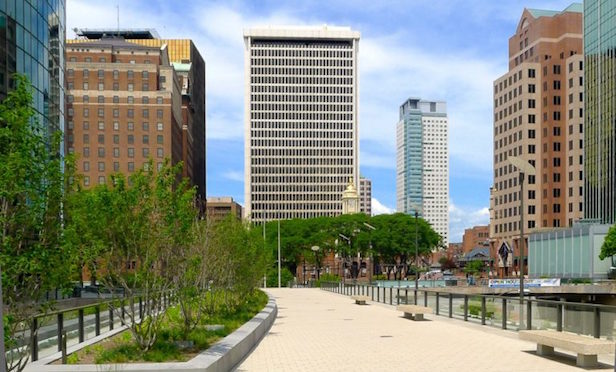
DARIEN, CT—Earlier this week, Greenworks Lending closed on what's reportedly the nation's first microgrid project financed through the Property Assessed Clean Energy (PACE) program, at the historic Hartford National Bank & Trust Building, 777 Main St. in Hartford, CT. A $1.1-million commercial PACE (C-PACE) investment helped fund the property's renovation into a LEED Platinum mixed-use residential and commercial building. This occurred five weeks after Darien, CT-based Greenworks closed financing on the first C-PACE project in Maryland.
On its website, Greenworks—which grew out of the most successful C-PACE program in the country during 2013 and 2014—describes PACE as the nation's fastest-growing financing option for clean energy upgrades. “It starts with a government policy that classifies clean energy upgrades as a permanent public benefit—like a new sewer, water line or road. These upgrades can be financed with no money down and then repaid as a benefit assessment on the property tax bill over long term (over 20 years). The assessment transfers on sale and can be passed through to tenants where appropriate. It's easy to see why building owners across the country are choosing PACE.”
GlobeSt.com recently spoke with Greenworks CEO Jessica Bailey, who co-founded the company with CIO Alexandra Cooley, about the track record of her company and the PACE program.
GlobeSt.com: Tell us about the formation of Greenworks Lending and the approach you take. Certainly the fact that you ran such a high-volume PACE program was a factor.
Jessica Bailey: My founding partner and I started at the Connecticut Green Bank just after it began, and we designed the commercial PACE program for the State of Connecticut through the Green Bank. We designed a go-to-market strategy around origination that led with contractors and enabled contractors to use C-PACE financing to sell more projects, whether they were solar, HVAC or mechanical upgrades. Then we also designed an underwriting and liquidity strategy for the assets themselves. We figured out how to lend to what today is a hard-to-lend-to class of assets—small to mid-sized businesses that don't have investment grade credit and often have somewhat complicated ownership structures. PACE allowed us to lend to this class of buildings through the state.
About six to 12 months into the program, we started to see volume growing quite substantially. We got about $20 million worth of transactions through the C-PACE program in our first year, and doubled that in our second year. We made the decision that the model that we had incubated inside the Connecticut Green Bank could be both scaled up and scaled out nationally if we built a private company around it. That's really where Greenworks Lending came from.
GlobeSt: In scaling the program out, a big part of that relates to the states that have PACE in place. What is the history with regard to states introducing these programs?
Bailey: The first PACE project was in California, in 2008. Since then, about three dozen states have passed policies that allow PACE financing to come into their states. Most of those states have been in the past two years, and we've seen both Democrat- and Republican-led states embrace PACE policy as a way to allow the private sector to invest in clean energy and economic development in their states. It's a very nice bipartisan policy that allows governments to do what government does best, which is to set up structures that allow the private sector to scale solutions for societal problems, including climate change and challenges around economic development.
GlobeSt.com: Aside from the fact that more states are involved, has the climate for PACE funding improved over the past few years?
Bailey: Absolutely. We've seen a real uptick in political support for PACE; you even saw the President of the United States come out in support of PACE in a video he released a couple of months ago, talking about how PACE is a real source of capital to upgrade facilities, to drop their operating expenses and of course to contribute to climate change solutions.
GlobeSt.com: Are there any headwinds facing either borrowers or lenders in the current finance climate?
Bailey: I don't see any real headwinds. The truth is that PACE is the ultimate in public-private partnerships, so our ability as a private company to make investments in buildings is dependent entirely on the public sector's engagement. As long as the private sector respects the intent of the public sector in having put these programs in place, they will continue to thrive.
By “respect the intent,” I mean that it's very clear that in states that have passed PACE policy, it's understood that PACE financing flows to things that are of public benefit: clean energy programs that promote economic development, that prevent climate change, that create jobs and help owners drop their operating expenses. As long as PACE financing stays focused on those things that the government passed policy to allow them to fund, I don't see any limit to the growth of the market.

DARIEN, CT—Earlier this week, Greenworks Lending closed on what's reportedly the nation's first microgrid project financed through the Property Assessed Clean Energy (PACE) program, at the historic Hartford National Bank & Trust Building, 777 Main St. in Hartford, CT. A $1.1-million commercial PACE (C-PACE) investment helped fund the property's renovation into a LEED Platinum mixed-use residential and commercial building. This occurred five weeks after Darien, CT-based Greenworks closed financing on the first C-PACE project in Maryland.
On its website, Greenworks—which grew out of the most successful C-PACE program in the country during 2013 and 2014—describes PACE as the nation's fastest-growing financing option for clean energy upgrades. “It starts with a government policy that classifies clean energy upgrades as a permanent public benefit—like a new sewer, water line or road. These upgrades can be financed with no money down and then repaid as a benefit assessment on the property tax bill over long term (over 20 years). The assessment transfers on sale and can be passed through to tenants where appropriate. It's easy to see why building owners across the country are choosing PACE.”
GlobeSt.com recently spoke with Greenworks CEO Jessica Bailey, who co-founded the company with CIO Alexandra
GlobeSt.com: Tell us about the formation of Greenworks Lending and the approach you take. Certainly the fact that you ran such a high-volume PACE program was a factor.
Jessica Bailey: My founding partner and I started at the Connecticut Green Bank just after it began, and we designed the commercial PACE program for the State of Connecticut through the Green Bank. We designed a go-to-market strategy around origination that led with contractors and enabled contractors to use C-PACE financing to sell more projects, whether they were solar, HVAC or mechanical upgrades. Then we also designed an underwriting and liquidity strategy for the assets themselves. We figured out how to lend to what today is a hard-to-lend-to class of assets—small to mid-sized businesses that don't have investment grade credit and often have somewhat complicated ownership structures. PACE allowed us to lend to this class of buildings through the state.
About six to 12 months into the program, we started to see volume growing quite substantially. We got about $20 million worth of transactions through the C-PACE program in our first year, and doubled that in our second year. We made the decision that the model that we had incubated inside the Connecticut Green Bank could be both scaled up and scaled out nationally if we built a private company around it. That's really where Greenworks Lending came from.
GlobeSt: In scaling the program out, a big part of that relates to the states that have PACE in place. What is the history with regard to states introducing these programs?
Bailey: The first PACE project was in California, in 2008. Since then, about three dozen states have passed policies that allow PACE financing to come into their states. Most of those states have been in the past two years, and we've seen both Democrat- and Republican-led states embrace PACE policy as a way to allow the private sector to invest in clean energy and economic development in their states. It's a very nice bipartisan policy that allows governments to do what government does best, which is to set up structures that allow the private sector to scale solutions for societal problems, including climate change and challenges around economic development.
GlobeSt.com: Aside from the fact that more states are involved, has the climate for PACE funding improved over the past few years?
Bailey: Absolutely. We've seen a real uptick in political support for PACE; you even saw the President of the United States come out in support of PACE in a video he released a couple of months ago, talking about how PACE is a real source of capital to upgrade facilities, to drop their operating expenses and of course to contribute to climate change solutions.
GlobeSt.com: Are there any headwinds facing either borrowers or lenders in the current finance climate?
Bailey: I don't see any real headwinds. The truth is that PACE is the ultimate in public-private partnerships, so our ability as a private company to make investments in buildings is dependent entirely on the public sector's engagement. As long as the private sector respects the intent of the public sector in having put these programs in place, they will continue to thrive.
By “respect the intent,” I mean that it's very clear that in states that have passed PACE policy, it's understood that PACE financing flows to things that are of public benefit: clean energy programs that promote economic development, that prevent climate change, that create jobs and help owners drop their operating expenses. As long as PACE financing stays focused on those things that the government passed policy to allow them to fund, I don't see any limit to the growth of the market.
Want to continue reading?
Become a Free ALM Digital Reader.
Once you are an ALM Digital Member, you’ll receive:
- Breaking commercial real estate news and analysis, on-site and via our newsletters and custom alerts
- Educational webcasts, white papers, and ebooks from industry thought leaders
- Critical coverage of the property casualty insurance and financial advisory markets on our other ALM sites, PropertyCasualty360 and ThinkAdvisor
Already have an account? Sign In Now
*May exclude premium content© 2025 ALM Global, LLC, All Rights Reserved. Request academic re-use from www.copyright.com. All other uses, submit a request to [email protected]. For more information visit Asset & Logo Licensing.








